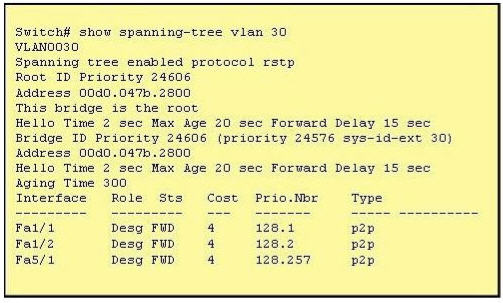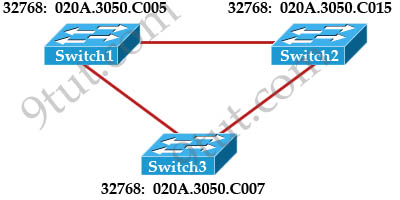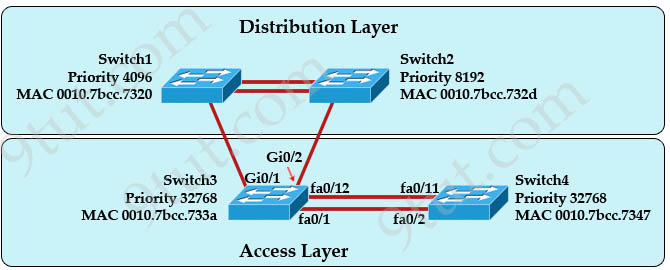CCNA – STP Questions 2
Here you will find answers to STP Questions – Part 2
Note: If you are not sure about STP, please read my STP tutorial and RSTP tutorial.
Question 1
Which term describes a spanning-tree network that has all switch ports in either the blocking or forwarding state?
A. redundant
B. spanned
C. provisioned
D. converged
Answer: D
Explanation
Spanning Tree Protocol convergence (Layer 2 convergence) happens when bridges and switches have transitioned to either the forwarding or blocking state. When layer 2 is converged, root bridge is elected and all port roles (Root, Designated and Non-Designated) in all switches are selected.
Question 2
Which two values are used by Spanning Tree Protocol to elect a root bridge? (Choose two)
A. amount of RAM
B. bridge priority
C. IOS version
D. IP address
E. MAC address
F. speed of the links
Answer: B E
Explanation
Bridge ID = Bridge Priority + MAC Address
For example:
+ The bridge priority of SwA is 32768 and its MAC address is 0000.0000.9999 -> the bridge ID of SwA is 32768:0000.0000.9999
+ The bridge priority of SwB is 32768 and its MAC address is 0000.0000.1111 -> the bridge ID of SwB is 32768:0000.0000.1111
Question 3
Which command enhances the 802.1D convergence time on ports that are connected to hosts?
A. spanning-tree backbonefast
B. spanning-tree uplinkfast
C. spanning-tree portfast
D. spanning-tree cost512
Answer: C
Explanation
By using PortFast feature, the port won’t spend 50 seconds to move from blocking (20sec), listening (15sec), learning (15sec) and finally forwarding but will jump directly to the forwarding state. This feature should be used on ports connected to hosts only because hosts surely don’t send BPDU. An example of configuring PortFast on an interface is shown below:
Sw(config)#interface FastEthernet0/1
Sw(config-if)#spanning-tree portfast
Question 4
Which two of these are used by bridges and switches to prevent loops in a layer 2 network? (Choose two)
A. 802.1D
B. VTP
C. 802.1Q
D. STP
E. SAP
Answer: A D
Explanation
Both 802.1D and STP are referred to the STP standard which is used by bridges and switches to prevent loops in a layer 2 network.
Question 5
Refer to the exhibit. The output that is shown is generated at a switch. Which three of these statements are true? (Choose three)

A. All ports will be in a state of discarding, learning or forwarding.
B. Thirty VLANs have been configured on this switch.
C. The bridge priority is lower than the default value for spanning tree.
D. All interfaces that are shown are on shared media.
E. All designated ports are in a forwarding state.
F. The switch must be the root bridge for all VLANs on this switch.
Answer: A C E
Explanation
From the output, we see that all ports are in Designated role (forwarding state) -> A and E are correct.
The command “show spanning-tree vlan 30” only shows us information about VLAN 30. We don’t know how many VLAN exists in this switch -> B is not correct.
The bridge priority of this switch is 24606 which is lower than the default value bridge priority 32768 -> C is correct.
All three interfaces on this switch have the connection type “p2p”, which means Point-to-point environment – not a shared media -> D is not correct.
The only thing we can specify is this switch is the root bridge for VLAN 3o but we can not guarantee it is also the root bridge for other VLANs -> F is not correct.
Question 6
What is one benefit of PVST+?
A. PVST+ reduces the CPU cycles for all the switches in the network.
B. PVST+ automatically selects the root bridge location, to provide optimization.
C. PVST+ allows the root switch location to be optimized per vlan.
D. PVST+ supports Layer 3 load balancing without loops.
Answer: C
Explanation
Per VLAN Spanning Tree (PVST) maintains a spanning tree instance for each VLAN configured in the network. It means a switch can be the root bridge of a VLAN while another switch can be the root bridge of other VLANs in a common topology. For example, Switch 1 can be the root bridge for Voice data while Switch 2 can be the root bridge for Video data. If designed correctly, it can optimize the network traffic.
Question 7
Which IEEE standard protocol is initiated as a result of successful DTP completion in a switch over FastEthernet?
A. 802.3ad
B. 802.1w
C. 802.1Q
D. 802.1d
Answer: C
Explanation
Dynamic Trunking Protocol (DTP) is a Cisco proprietary protocol for negotiating trunking on a link between two devices and for negotiating the type of trunking encapsulation (802.1Q) to be used.
Question 8
What value is primarily used to determine which port becomes the root port on each non-root switch in a spanning-tree topology?
A. lowest port MAC address
B. port priority number and MAC address.
C. VTP revision number
D. highest port priority number.
E. path cost
Answer: E
Explanation
The path cost to the root bridge is the most important value to determine which port will become the root port on each non-root switch. In particular, the port with lowest cost to the root bridge will become root port (on non-root switch).
Question 9
When PVST+ in work on VLAN1 of the switch, what will affect on selection of one of switches in the VLAN as root-bridge?
A. Lowest IP address
B. Highest MAC address
C. Lowest MAC address
D. Highest IP address
Answer: C
Explanation
The two values used to select the root bridge are Bridge Priority & MAC address (the lower is better) -> C is correct.
Question 10
Refer to the exhibit. A network administrator wants Switch3 to be the root bridge. What could be done to ensure Switch3 will be the root?

A. Configure the IP address on Switch3 to be higher than the IP addresses of Switch1 and Switch2.
B. Configure the priority value on Switch3 to be higher than the priority values of Switch 1 and Switch2.
C. Configure the BID on Switch3 to be lower than the BIDs of Switch1 and Switch2.
D. Configure the MAC address on Switch3 to be higher than the Switch1 and Switch2 MAC addresses.
E. Configure a loopback interface on Switch3 with an IP address lower than any IP address on Switch1 and Switch2.
Answer: C
Explanation
To become root bridge, a switch must have lower Bridge ID (BID) than that of the others. The Bridge ID = Bridge Priority + MAC address; but MAC address is a fixed value so we can only change the BID by changing the Bridge Priority of that switch.
Question 11
Which port state is introduced by Rapid-PVST?
A. learning
B. listening
C. discarding
D. forwarding
Answer: C
Explanation
PVST+ is based on IEEE802.1D Spanning Tree Protocol (STP). But PVST+ has only 3 port states (discarding, learning and forwarding) while STP has 5 port states (blocking, listening, learning, forwarding and disabled). So discarding is a new port state in PVST+.
Question 12
At which layer of the OSI model is RSTP used to prevent loops?
A. data link
B. network
C. physical
D. transport
Answer: A
Explanation
RSTP and STP operate on switches and are based on the exchange of Bridge Protocol Data Units (BPDUs) between switches. One of the most important fields in BPDUs is the Bridge Priority in which the MAC address is used to elect the Root Bridge -> RSTP operates at Layer 2 – Data Link layer -> A is correct.
Question 13
Refer to the exhibit. At the end of an RSTP election process, which access layer switch port will assume the discarding role?

A. Switch3, port fa0/1
B. Switch3, port fa0/12
C. Switch4, port fa0/11
D. Switch4, port fa0/2
E. Switch3, port Gi0/1
Answer: C
Explanation
In this question, we only care about the Access Layer switches (Switch3 & 4). Switch 3 has a lower bridge ID than Switch 4 (because the MAC of Switch3 is smaller than that of Switch4) so both ports of Switch3 will be in forwarding state. The alternative port will surely belong to Switch4.
Switch4 will need to block one of its ports to avoid a bridging loop between the two switches. But how does Switch4 select its blocked port? Well, the answer is based on the BPDUs it receives from Switch3. A BPDU is superior than another if it has:
1. A lower Root Bridge ID
2. A lower path cost to the Root
3. A lower Sending Bridge ID
4. A lower Sending Port ID
These four parameters are examined in order. In this specific case, all the BPDUs sent by Switch3 have the same Root Bridge ID, the same path cost to the Root and the same Sending Bridge ID. The only parameter left to select the best one is the Sending Port ID (Port ID = port priority + port index). In this case the port priorities are equal because they use the default value, so Switch4 will compare port index values, which are unique to each port on the switch, and because Fa0/12 is inferior to Fa0/1, Switch4 will select the port connected with Fa0/1 (of Switch3) as its root port and block the other port -> Port fa0/11 of Switch4 will be blocked (discarding role).
If you are still not sure about this question, please read my RSTP tutorial.


